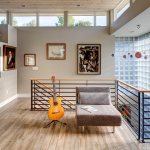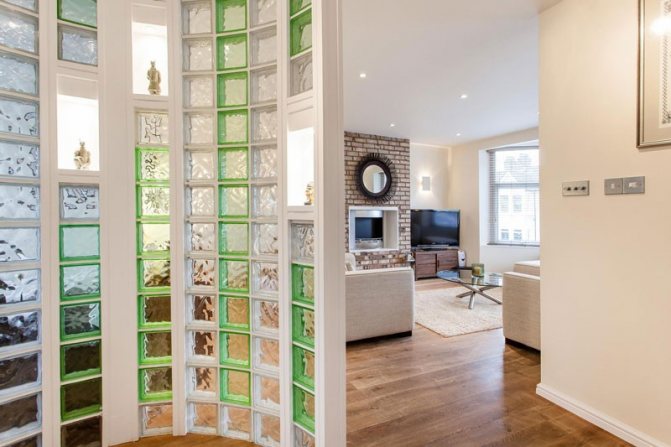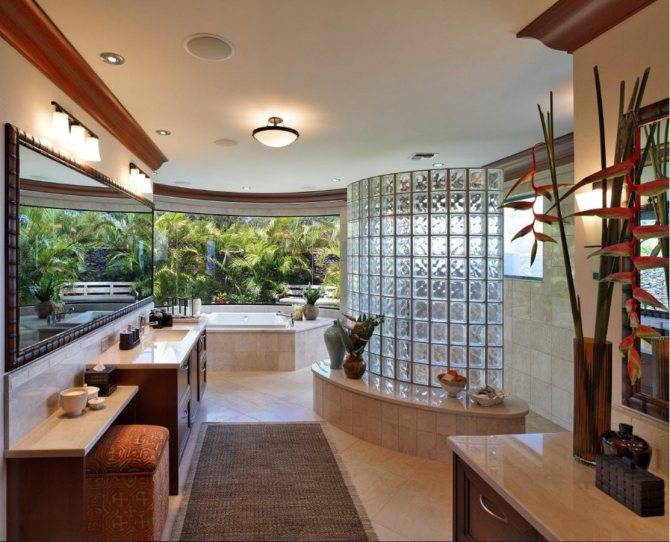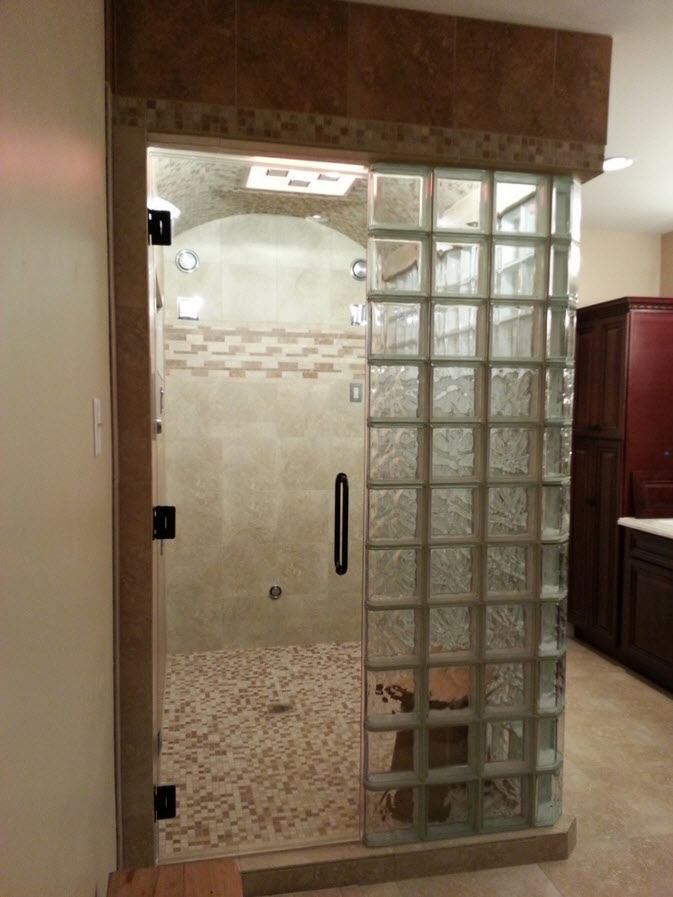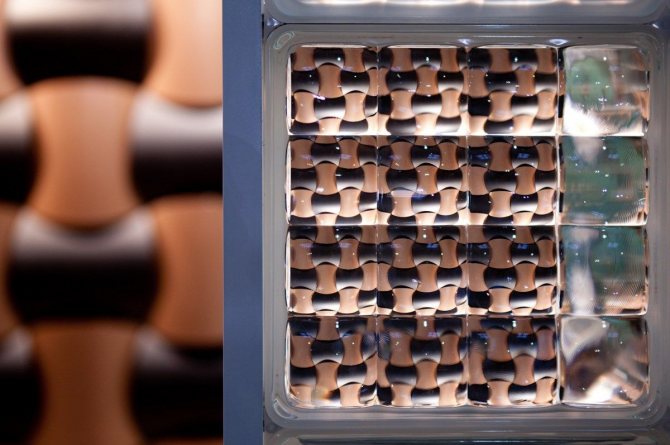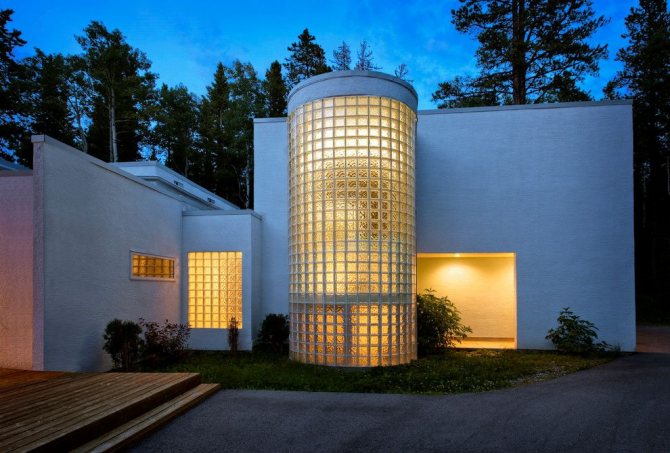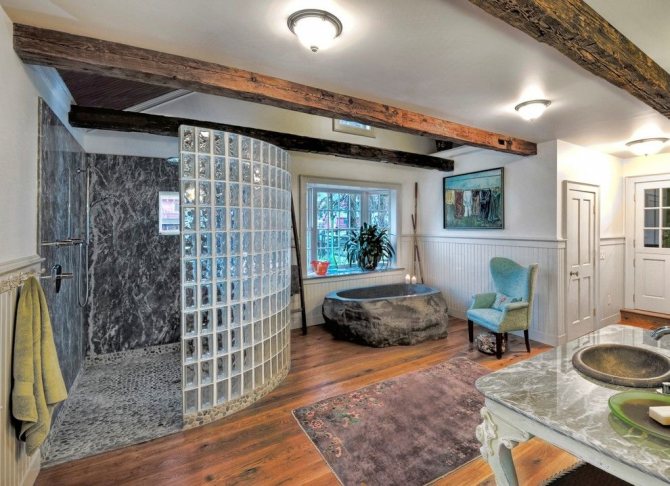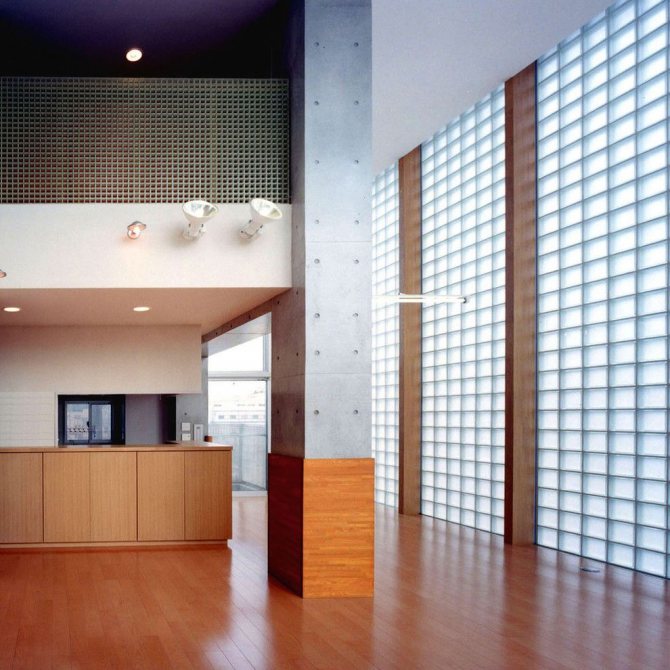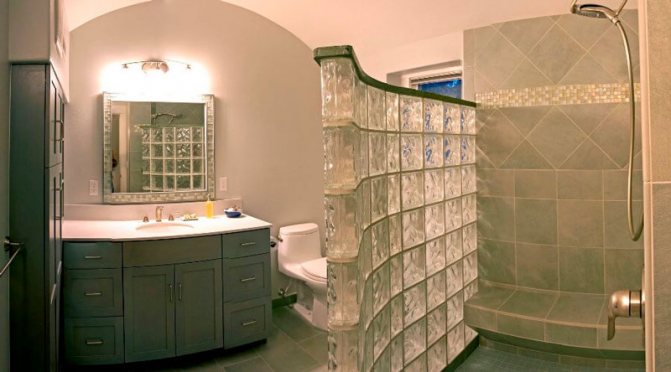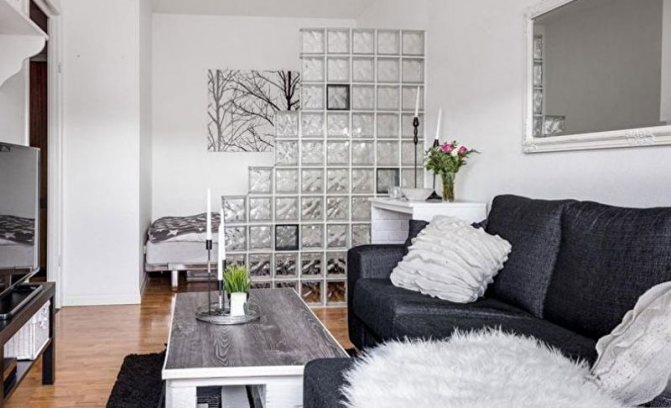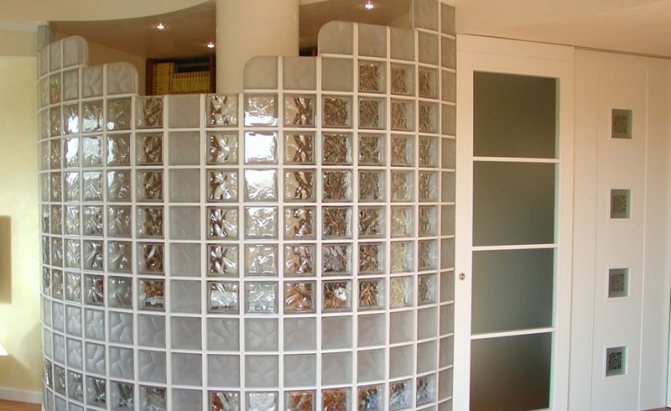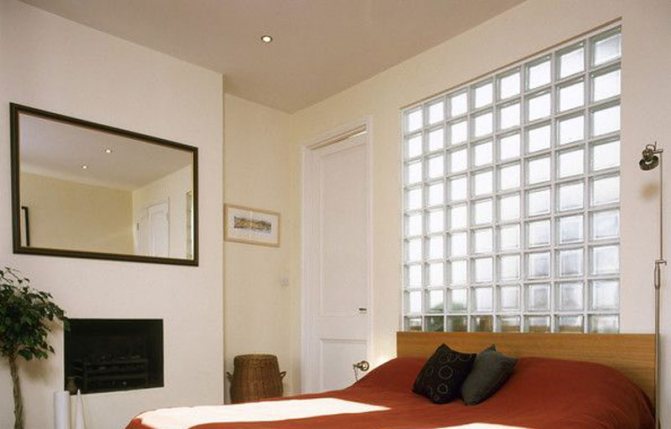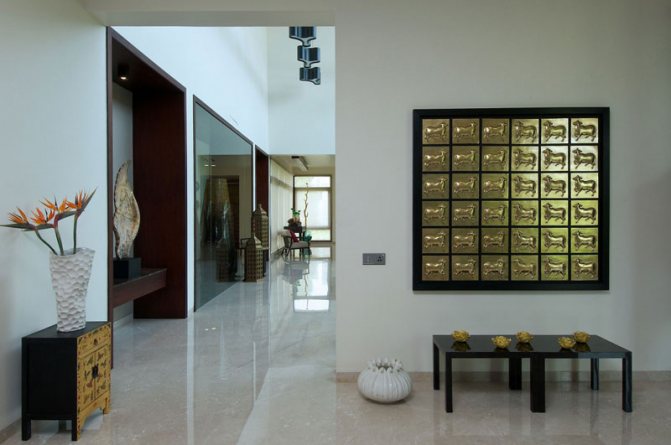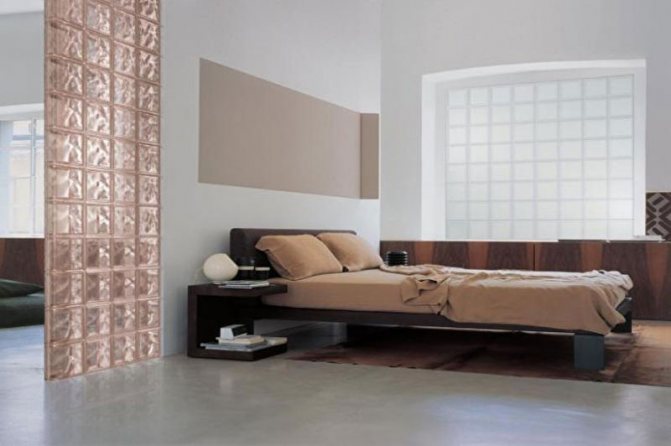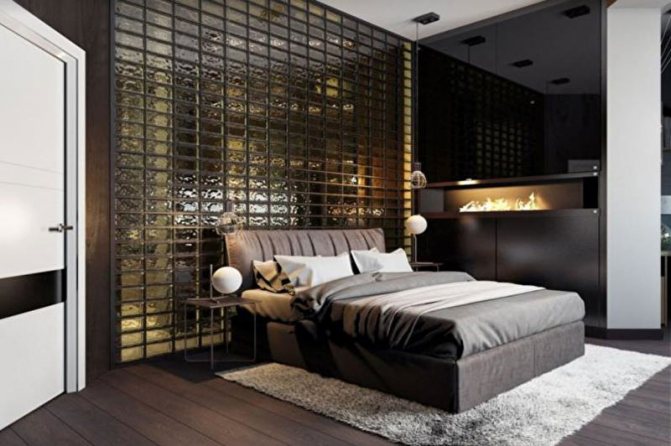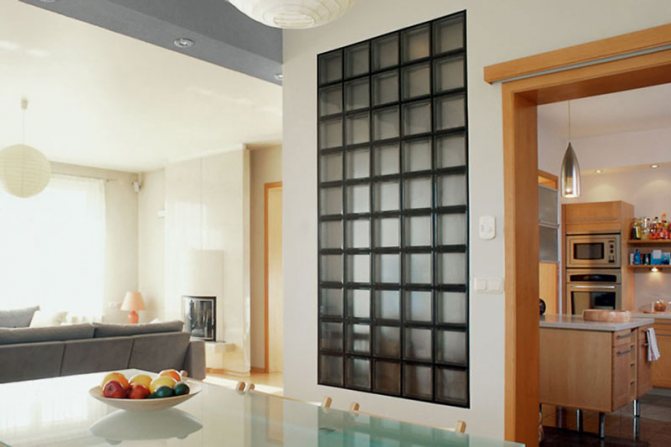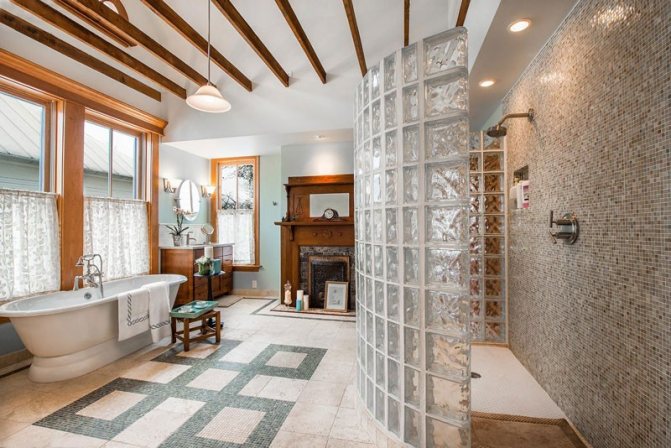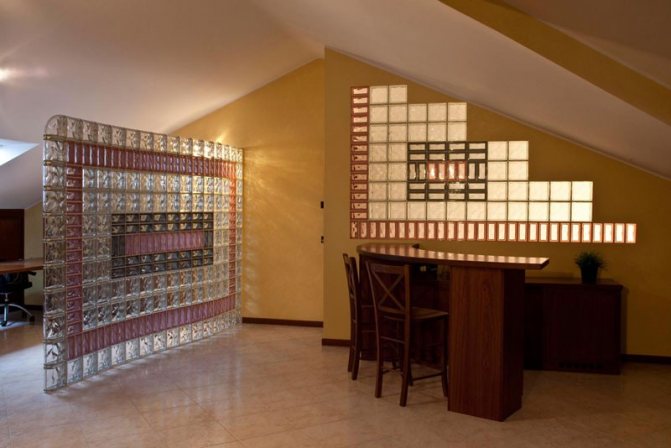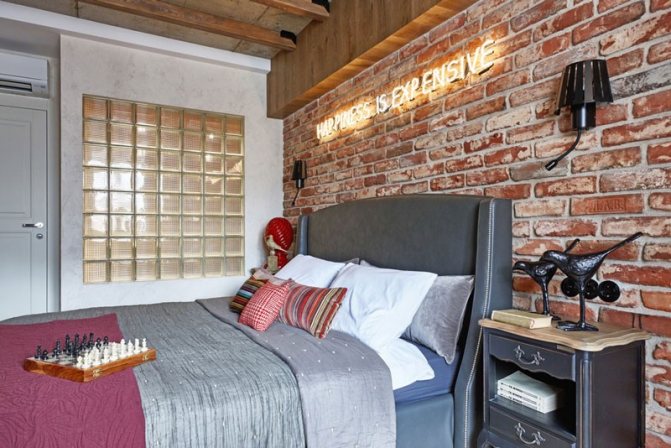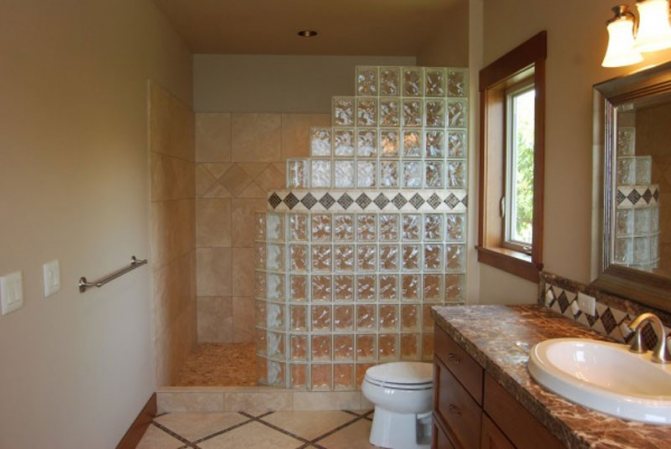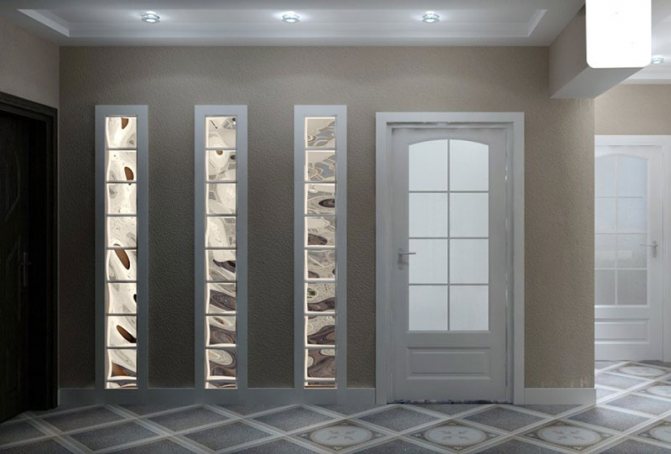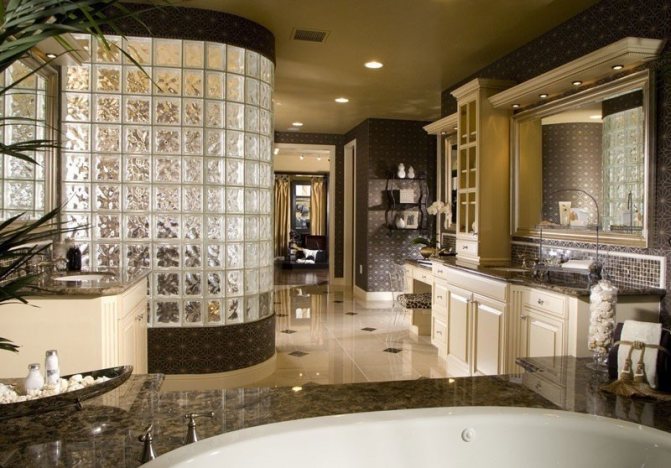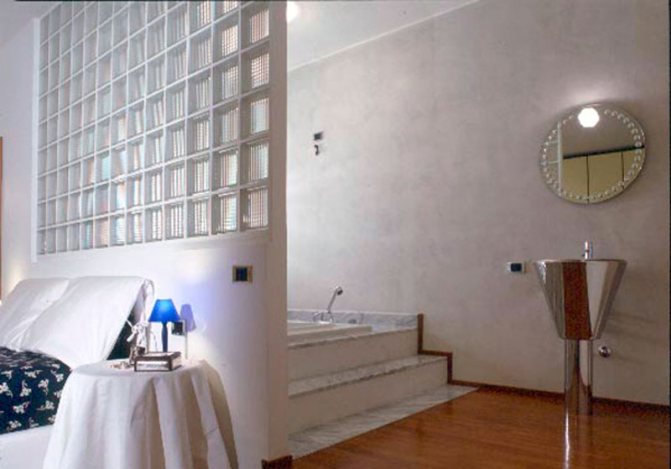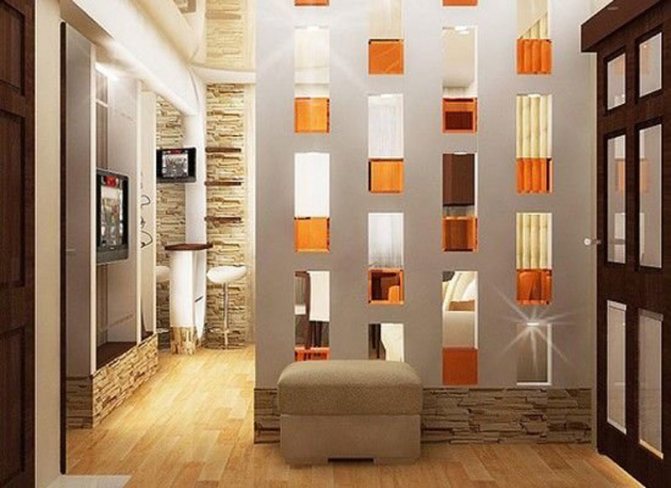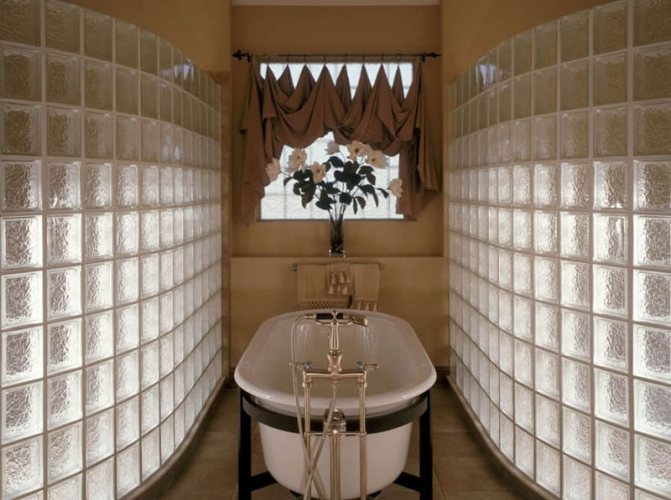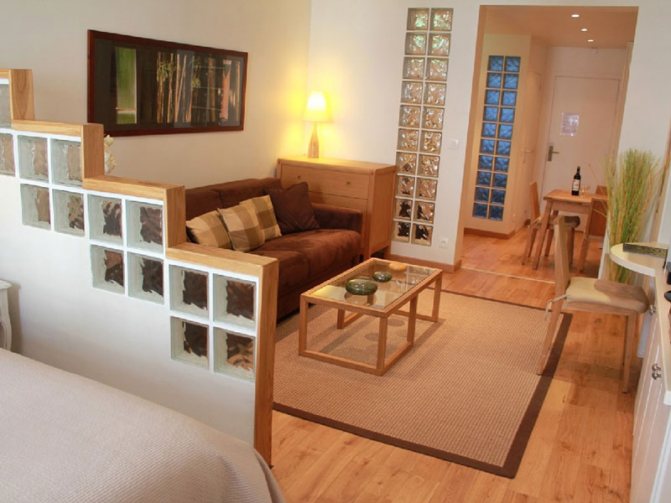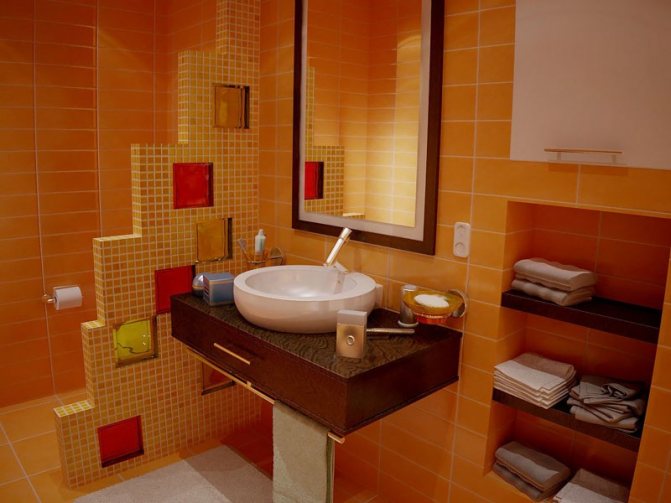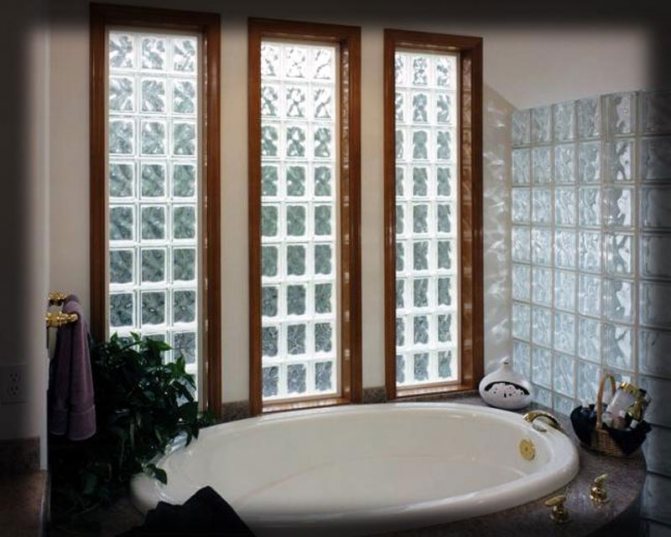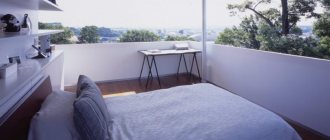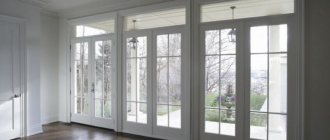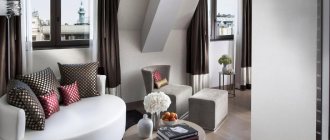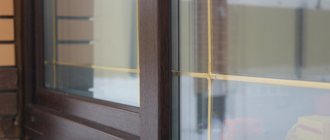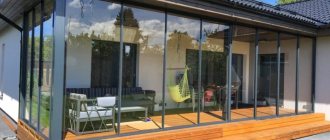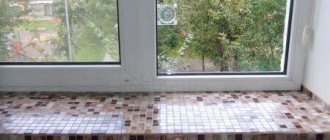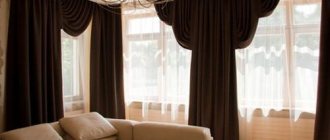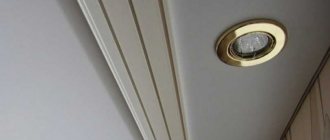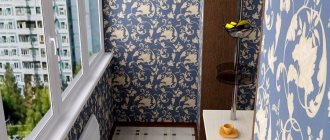Glass blocks and walls made of them are not a thing of the past, but they still live
Glass blocks as a building and finishing material were used back in Soviet times, but after going through decades and undergoing significant changes, glass bricks in a new image returned to perform decorative functions. In modern construction, this material is widely used due to its unique properties and bright variety.
What is a glass block?
The traditional glass block was a hollow cube with walls of glass about one centimeter thick, which, due to an internal air cushion, reduced sound transmission by 60-70%, light transmission was 80%, and dense glass washed out the outlines of people behind it and did not allow them to peep behind it. which was not meant for prying eyes.
In addition, they were very durable, so the glass walls made of cubes did not frighten either mothers in kindergartens or the residents of "Brezhnevoks", whose entrances were regularly decorated with blue-green glass delights.
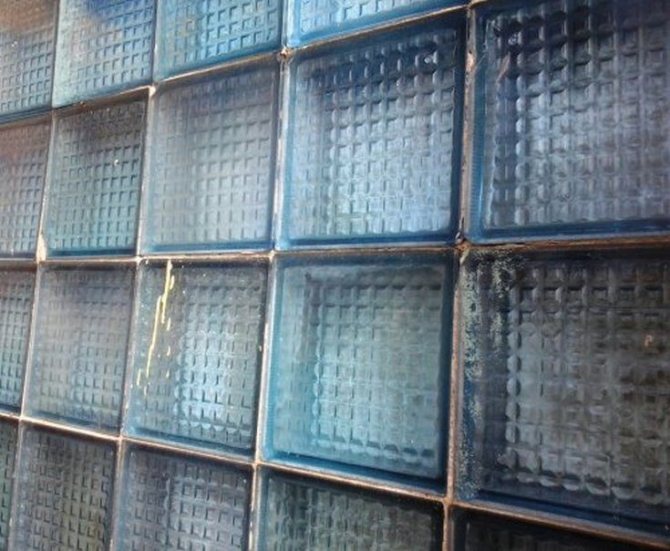
But as the wise Ovid said: “Tempora mutantur, et nos mutamur in illis” (trans.: Times change, and we change with them), glass blocks have changed, taking on new forms - for example, bricks; new content - they are filled with installations, herbaria or mother of pearl; a new look - decoration with ornaments or graphics, as well as painting glass in different colors.
The sizes of glass blocks in the interior of an apartment vary greatly, but the most popular are standard cubes 24x24x8 and 19x19x8.
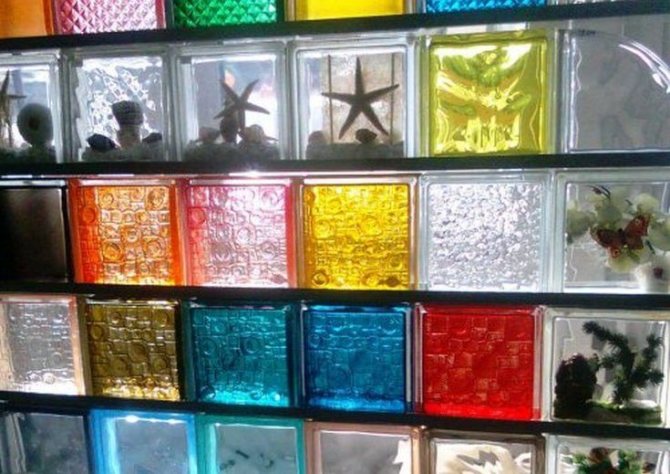

Types and features of material
So, what is this finishing material and how do glass blocks look in the interior? To put it simply, this is a kind of "sandwich", hollow inside, of two thick centimeter glasses combined with each other. In the Soviet Union, they were produced according to standards that have smoothly migrated to our days.
There are only two size ranges: 19x19x8 and the second - more - 24x24x8.
The indicators remained the same:
- "Filling" from the air makes it possible to get rid of external noise in the room by almost 70%;
- they perfectly transmit light, leaving what is happening inside the house closed from prying eyes;
- in terms of strength, this tile can be compared with a brick, it conducts heat better than its counterpart, but one piece weighs much more than a brick - up to four kilograms.
What has undergone significant changes today is the appearance of the tiles. Only a lazy person will not find a design and shape to his taste on the market today: with a pattern and monochromatic, with or without illumination, in the form of stained-glass windows or installations, decorated with flowers, corals and whatever your heart desires. Choose and Conquer.
The form has also undergone significant changes. Today you can find not only classic rectangles and squares, but also triangular and even round options.
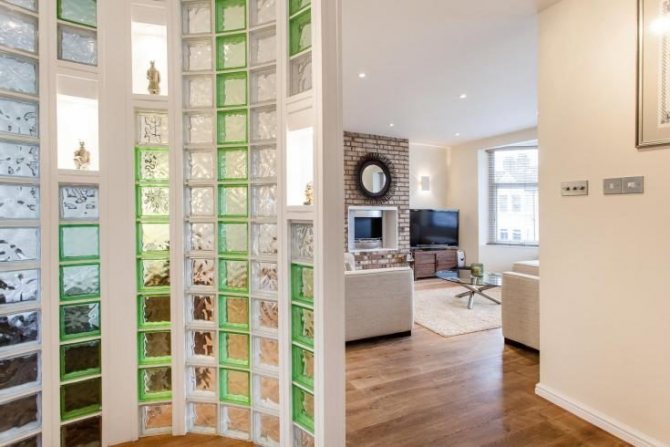

Properties of a glass block as a building material
A glass block is a hollow volumetric block of fused glass plates with a thickness of a little less than 1 cm. In shape, they are produced in square, rectangular, triangular and round. The most in demand are square blocks with standard dimensions of 190x190 mm and 240x240 mm with a thickness of 80 to 100 mm. The weight of an individual block depends on the size and averages 3-4 kg. In general, a glass block is a glass brick with a sealed air chamber inside.
Physical properties of the material:
- high light transmittance;
- good heat and sound insulation;
- high level of fire resistance;
- high strength and resistance to cracking;
- resistance to condensation.
Glass is chemically inert and environmentally friendly. Due to the hollow construction of the blocks, in case of damage, the fragments will be inside, which is safe in operation. They do not require the use of special detergents and are easy to clean.
Advantages and disadvantages of finishing material
pros
It is possible to harmoniously fit glass, given its characteristics, into almost any room.
- Strength - a wall of glass blocks will look good in the interior and are guaranteed to serve you for many years.
- Moisture resistance - that is why glass blocks are very popular in bathrooms.
- Easy to clean. A special glass cleaner, a rag and five minutes of time are all you need.
- Noise isolation. Noise of water, screams in the street or loud music - you can forget about these annoying factors.
- Thermal conductivity. Glass blocks work well with the air temperature in the room: by keeping the required level of heat, they make your home even more comfortable.
- Light transmission. The thickness of one layer of glass is more than a centimeter, but this does not at all interfere with letting in almost all the sunlight from the outside into the house - up to 90%.
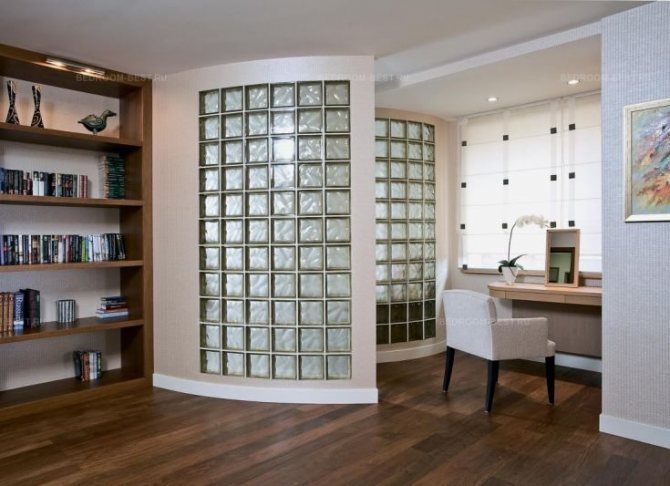

Minuses
Almost perfect finish, isn't it? But what's the catch? As a rule, it is clarified at the installation stage.
The thing is that in order to build a structure, you just need professional skills. And if you do not have them, be prepared to spend money on a specialist, otherwise you risk overwhelming the entire aesthetic component of the issue.
- Weight. As already mentioned, it is about 4 kilograms per square. This not only complicates the construction process, but also constitutes a significant burden in the overall engineering plan of the premises. Simply put - if you do not want to fall through to the neighbors from below, you should not decorate the surface of more than 15 square meters in this way.
- If you are a fan of decorating walls with paintings or photos, this item is for you. The fact is that screws or nails cannot be driven into a glass wall. Hanging a shelf, decorating with a picture or screwing on hooks - all this is not about glass blocks.
- The material must not be cut. This means that you will have to fully accept the terms dictated by the size of the source.
- Wiring cannot be made in such a wall.
- The design does not allow air to circulate. That is why you should not decorate window openings with them - the apartment will not breathe.


Kitchen
The kitchen, timeless, remains the most important room in the home. It is in the kitchen that the family gathers for dinner, this is the heart of the house.
The design of the kitchen must emphasize this position, make it comfortable for cooking and for mental gatherings. Glass blocks are ideal for dividing spaces and can also be used as colorful and decorative elements. Your kitchen can be a delightful place to cook or spend time with friends.
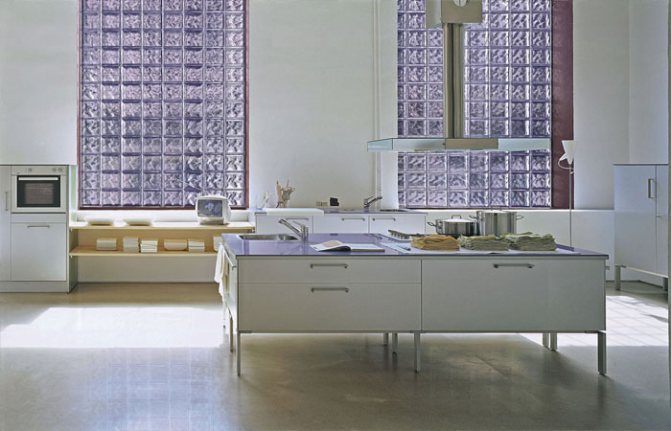

In the living room
Glass blocks in the living room interior can be used to create full-fledged partitions.
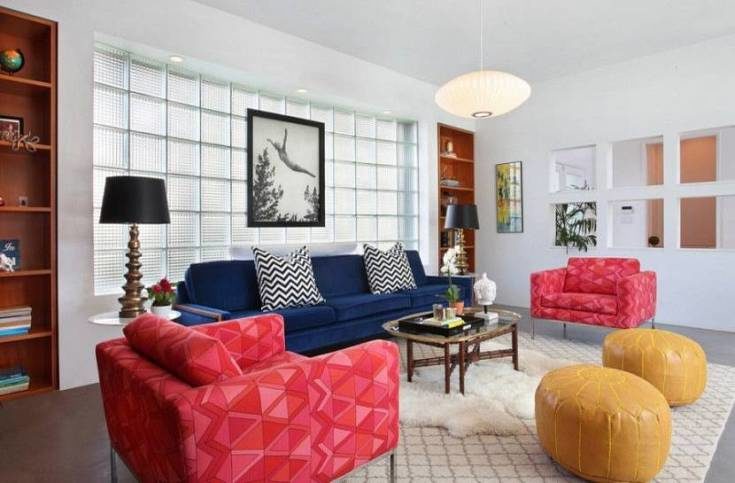

The use of glass elements in wall decor looks very interesting, stylish and unusual.
The material is used to erect the base of a small coffee table or a full-fledged dining table.
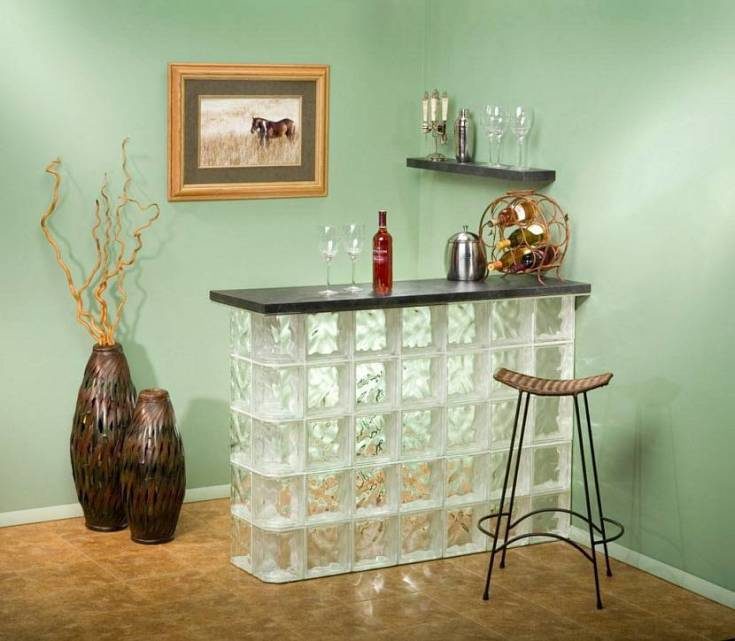

By decorating the walls with glass blocks, you can select the necessary area in the room.
In the bedroom
Glass blocks in the bedroom interior create a soothing and relaxing atmosphere, thanks to the ability to diffuse and refract light.
A glass block partition will help create a cozy atmosphere in the sleeping area.
Glass blocks can be used to decorate a doorway or part of a wall.
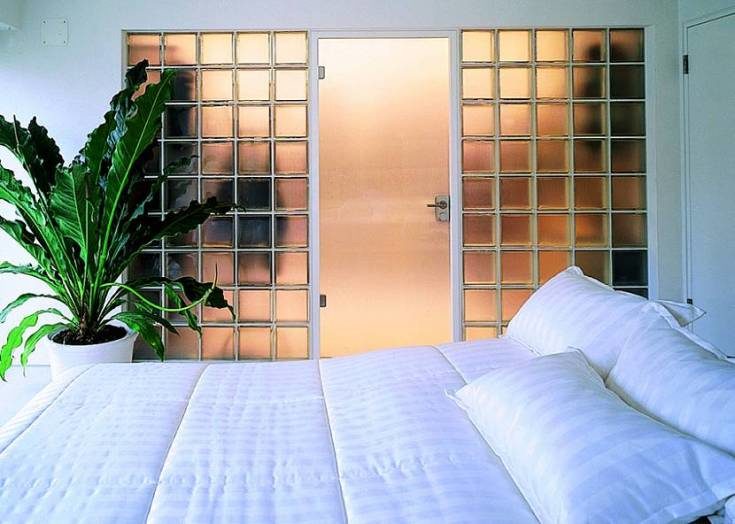

The block wall opposite the window will create a festive atmosphere in the room, especially if you choose colored glass blocks for decoration, for example, green.
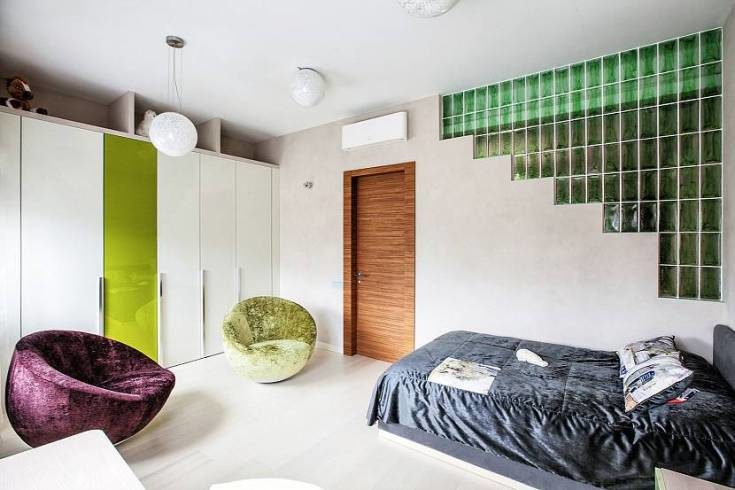

In the hall
In most cases, the hallways have a small area, in order to visually increase the space, you can use light shades in the interior or decorate the corridor with glass blocks.
The door to the living room can be replaced with a beautiful glass block arch.
The floor and ceiling can also be finished with sturdy materials such as blue. Near the wall, you can make a small table made of glass blocks.
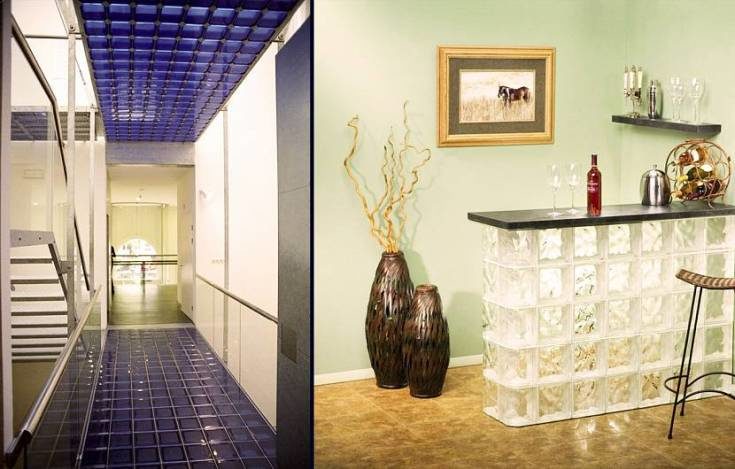

Adding glass blocks to the wall decoration will help improve the illumination of a poorly lit corridor.
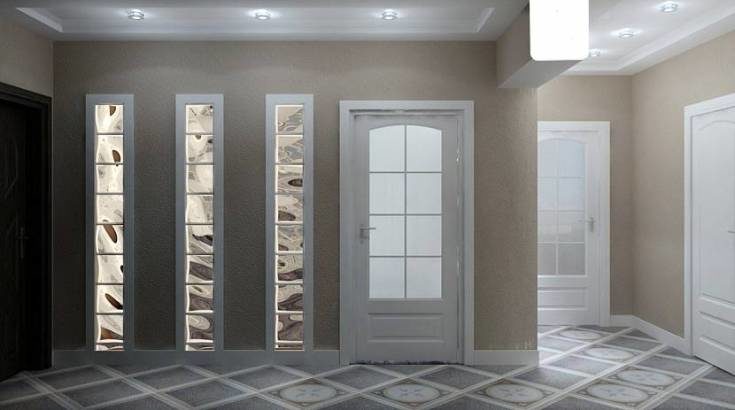

In the kitchen
Glass blocks are used more often in creating a kitchen interior. Glass material is used not only for decorating walls, window and doorways, but also for decorating a kitchen apron, decorating and zoning a room.
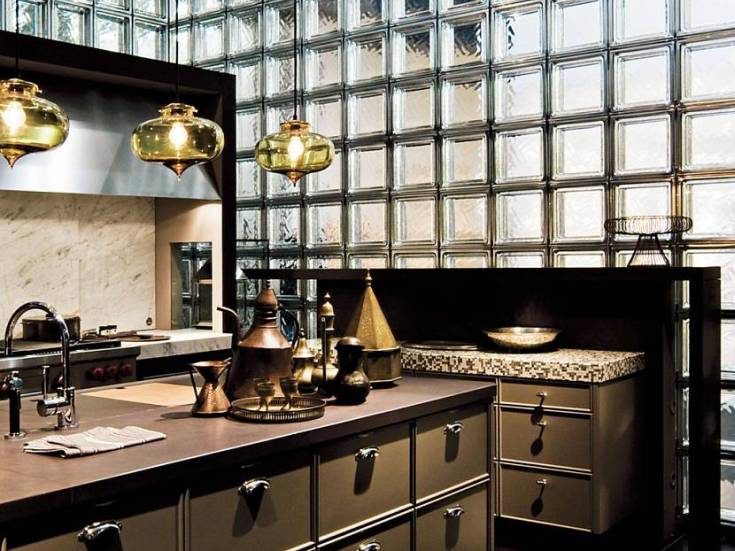

Recently, the base for the table has been made from glass blocks. This decor looks quite interesting and unusual.
Clear glass blocks go well with a white tint kitchen unit or wood trim.
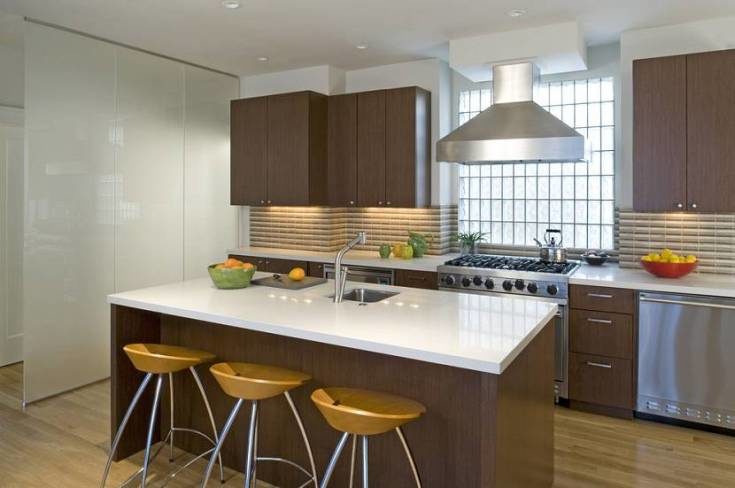

In what styles of interiors are glass blocks used?
Transparent and monotonous glass blocks are chosen for modern interior styles:
- Urban is the aesthetics of precise lines, bright colors and unprecedented practicality. Here, glass is the most popular material, so you can decorate skylights and stairwells with blocks. But it is better to choose furniture in contrast to more laconic and matte.
- Loft is a reflection of industrial interiors in home decoration. Interior partitions, as well as windows made of blocks, will perfectly zone the room and make it lighter. Glass tables and kitchen aprons will also come in handy. In addition, furniture or flooring made of this material will emphasize the overall brutality of the style.
- Hi-tech is a pragmatic and very technological style. In such an interior, every detail is laconic, functional and monumental. Glass blocks are useful here for minimalistic decor items and light reflection. Coffee tables, partitions and glass doors will also fall into the theme.
Multicolored glass and stained glass blocks emphasize the decorativeness of styles such as:
- Art Deco is a highly aesthetic and luxurious style from the beginning of the 20th century, in the era of which one of the waves of popularity of glass blocks fell. They love glamor and shine, geometric shapes, contrasting colors and an abundance of light. Glass blocks in Art Deco are used to create stained glass and mirror panels and aprons, as well as decorative columns. For greater gloss, glass is combined with glitter, gilded foil and mineral inclusions.
- Oriental styles - it can be both Arabic, African and Chinese interiors, as well as eclectic styles with elements of Persian, Indian and Egyptian. All these areas are characterized by bright colors and luxury. Semi-transparent doors and partitions, mosaic floors, arched decorative windows and false fireplaces made of glass blocks will be appropriate here.
- Art Nouveau or Art Nouveau - the style of waves and soft lines. Subdued color schemes are combined with attention to detail. Glass blocks can be used to create functional or decorative stained glass windows, as well as to decorate walls, stairs and pieces of furniture.
Sometimes glass blocks are appropriate in pop art, minimalism, eco-style and fusion. But where you should definitely not experiment with blocks is in interiors in the spirit of Gothic, Rococo, Empire, Classicism, country, Provence and retro.
Specifications
According to the technological features of the technical processing of glass, glass blocks are matte, embossed, even and smooth, glossy, colored, colorless, decorated.These indicators affect the light scattering effect and determine the light guide component.
Colorless variations have a transparency index of 70-90%, color - 50-70%, matte - up to 50%.
The material can have a colorless transparent base or decorative. It all depends on the design idea and scope. And you can choose any color scheme and art palette!
Glass LED blocks and illuminated "bricks" are in fashion. The illuminated decorative elements in the voids have a semblance of a 3D effect.
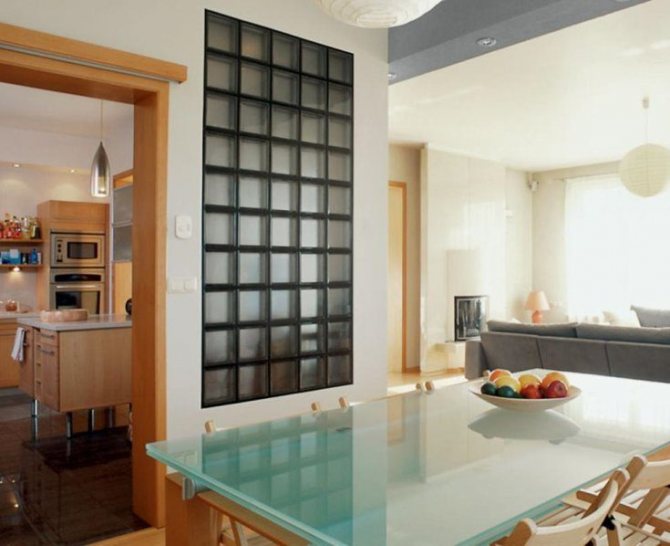

Classification of glass blocks by the outer surface
Today you can buy not only colorless transparent glass blocks with a smooth surface, but also decorative options. Depending on the area of application and the planned design, you can choose blocks of different colors (from neutral calm shades to bright flashy colors) and with different surface finishes (smooth, corrugated or patterned). The way the surface is treated affects the light transmittance of the glass and its transparency.
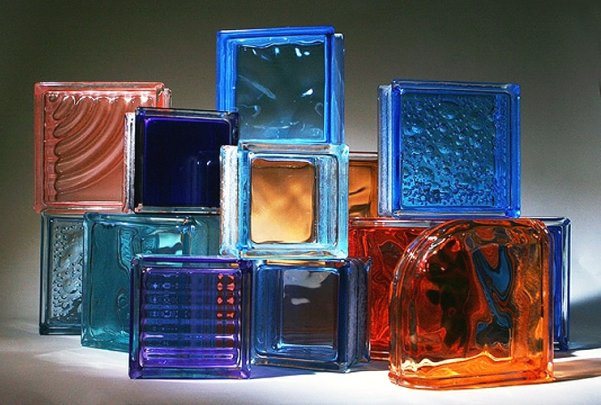

By the type of surface treatment, glass blocks are distinguished:
- even, smooth;
- glossy, with a mirror shine;
- matte;
- embossed.
Depending on the type of surface, the blocks can have a light-scattering or light-directing effect.
How to use glass blocks in home design
Walls and partitions are the most common type of application for the building and finishing material that has become universal. For this, it is as strong as possible, soundproof and moisture resistant.
The most successful and practical are translucent architectural structures in the interior of the dining room, bathroom, toilet.
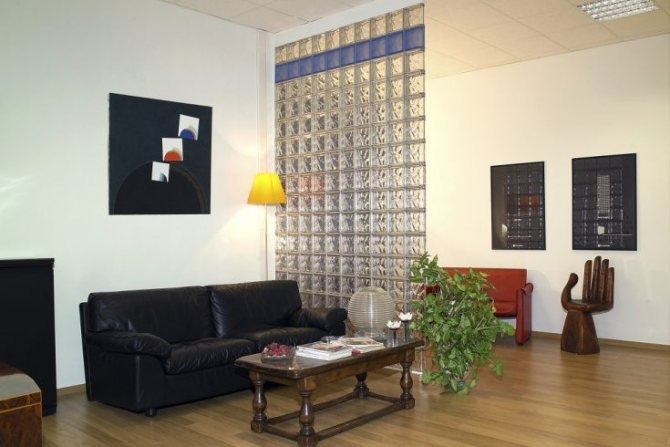

Partitions allow you to zone the studio space, walls - to delimit the semantic zones. For example, separate the bath from the toilet. Uniqueness and originality are achieved by using blocks of various colors and configurations in the construction.
In the kitchen, glass blocks look attractive in the decoration of the bar or island area in the form of stylized partitions.
Shower cabins are often made with semicircular partitions. Glass blocks do not allow water droplets to pass through and perfectly cope with the task of increased illumination: the penetration of natural light and the creation of an intimate environment, closed from prying eyes. Installations inside blocks made of decorative elements "imitating the aquatic environment", additional lighting will make the structures "alive" and original.
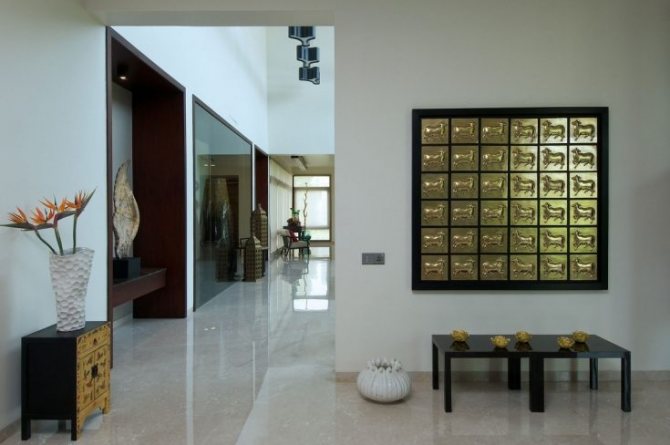

Glass block windows are most often used in technical rooms. These include utilitarian rooms - a bathroom and a toilet with a reservation. Instead of a "blank wall", a translucent window made of blocks in a private house is not only a bold, but also a practical, original solution. No additional curtains or blinds are required here.
At the same time, the sizes and configurations of window openings can be of the most intricate shape, different geometry and location on the wall.
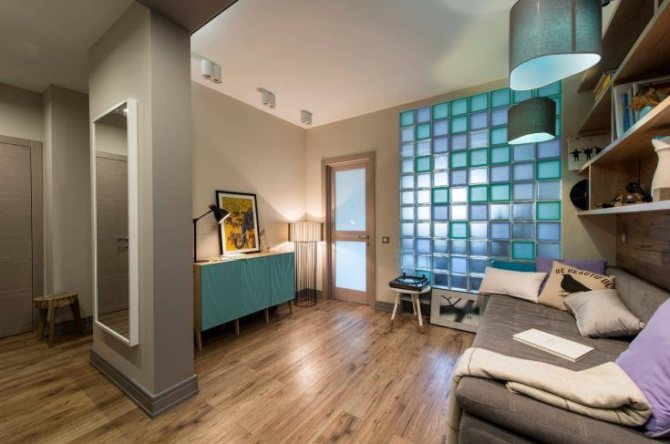

"Unexpected" solutions in the use of glass blocks in the interior:
- a semicircular counter island with illumination, serving as a bar area and a serving place for the dining room;
- fragmentary wall inserts made in a "chaotic" but thoughtful design key;
- the floor and roof of a private house made of a durable glass block will make an office, a greenhouse, a winter garden, an attic unique;
- a table made of glass blocks on a rigid frame for the strength of the entire structure.
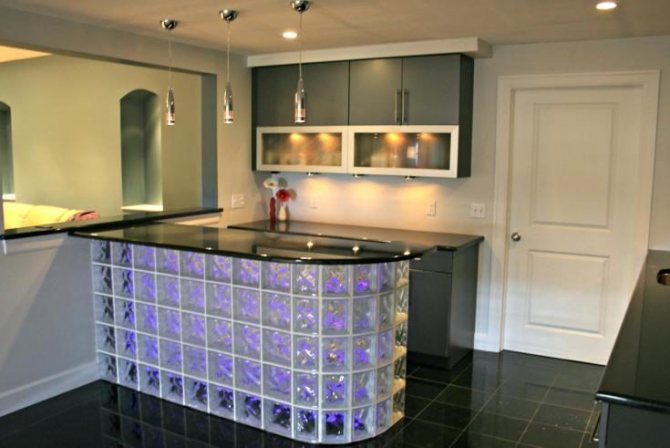

Views
Regarding the differences that modern decorative glass-block structures have. The material in question can be classified according to several criteria.
The size
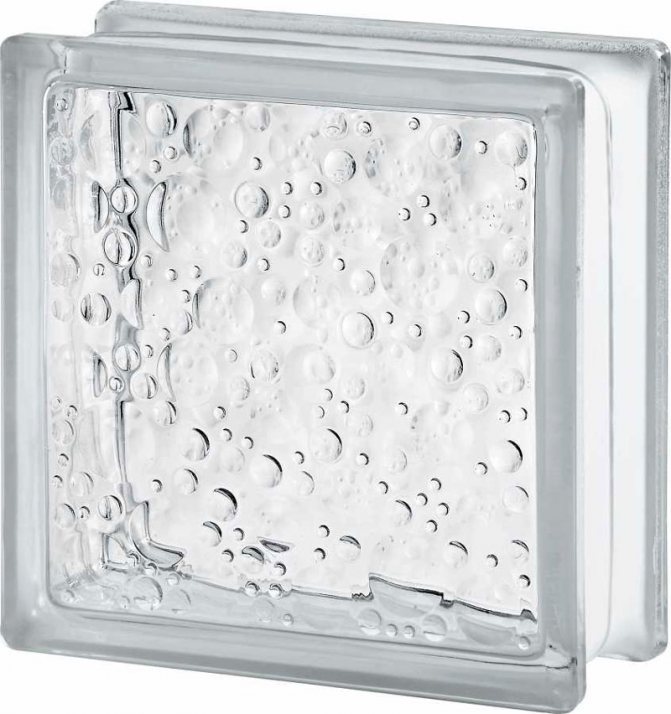

Here, all blocks are conventionally divided into half, hexagonal, rectangular, corner and brick-like. The most common type is rectangular. As a standard, it is believed that its dimensions are 190x190mm, one in European countries is produced and other variations.In the post-Soviet space, cubes with a side of twenty centimeters were widely produced, they were used to decorate production rooms and windows in the front ones.
The form
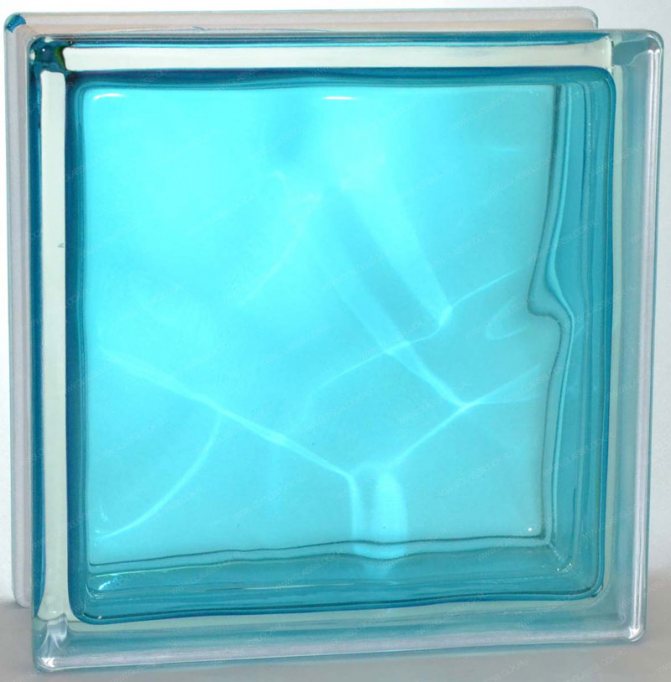

Here, the blocks are made as you like - in any fancy shape. For example, hexagonal ones, repeating a honeycomb, are used much less often than rectangular ones, but they can be used to assemble a much nicer wall, an element of the interior. The half-blocks got their name from their size (exactly half of the standard rectangle described above). Their main field of application is directly related to the creation of translucent radial structures (semicircular balconies, elevator shafts). And corner blocks are used in rotary masonry structures. The same can be said about the bricks - they fully correspond to the size and shape of a standard brick.
Color
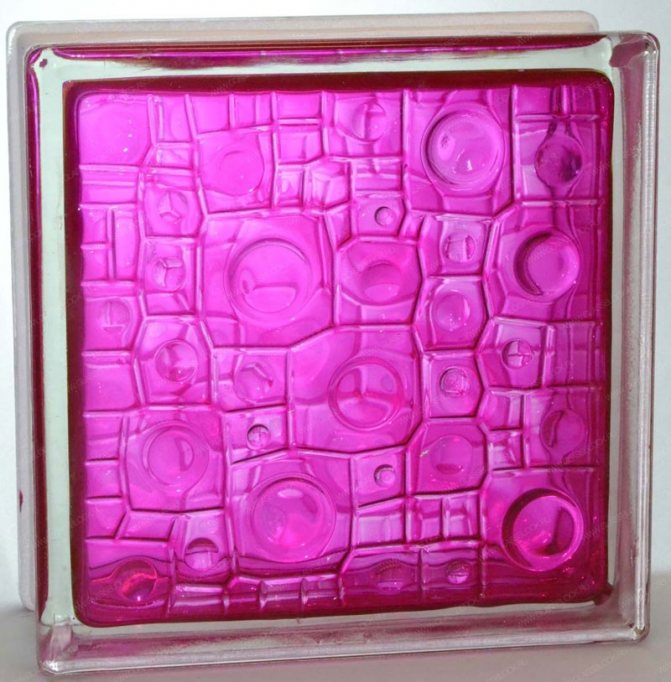

Colorized glass blocks differ in the way they are dyed - some of them are colored at the time of melting the glass itself, and others - especially after the formation of the blocks. It is important to understand: surface painting, as opposed to deep, is less durable. Nowadays, the coloring of ready-made compositions or the use of tinting inside the block is popular - this is how colored lamps are created.
Texture
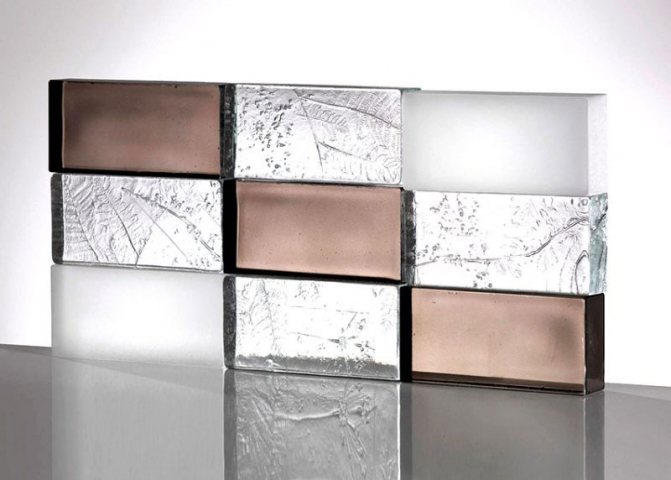

First of all, we need to note the transparent structure - here they can be colorless, that is, not colored (their transparency ranges from seventy-five to ninety percent) and colorized, their transparency coefficient is lower than the others and ranges from fifty to seventy percent. The first solution is used in masonry walls, and the second is more suitable for local decorative inserts, although it is not contraindicated for the manufacture of small walls and partitions.
Separately, let's say about the nature of the glass: they distinguish between completely transparent or matte, their surface may differ in relief, be smooth. It is also important to make them using the stained glass technique or equip them with internal inserts (fillers), provide an entrance for lighting and other decorative elements.
Rules for decorating a room with glass blocks
- This material is "contraindicated" to the classics of styles: directly to classicism, Renaissance, Baroque, Gothic, Empire. It is not always appropriate for rural areas: Provence, country, when wood is used in construction and decoration.
- In the design and architectural community, it is considered to be the most harmonious ratio of glass blocks to other finishing components of a separate living space as 1 to 10. At the same time, the toilet and bathtub do not have such restrictive recommendations.
- Glass blocks should not be the basis of load-bearing structures. They carry out an exclusively decorative and design function.
- They are also good at zoning any space, especially studio variations.
- It is advisable to "balance" the use of transparent colorless materials in the living room with bright notes of the color scheme in order to completely get away from the impression of "office".
- Glass blends harmoniously with metal, wood, parquet, laminate, carpets, fabric base and wallpaper.
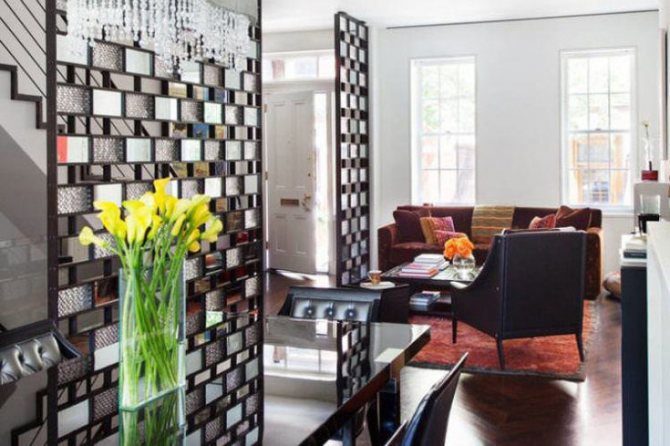

Endless design possibilities
Most often, you can find glass blocks in the bathroom or in the kitchen. In the interior of a children's room, bedroom or living room, they are used less often, rather as a decor than a functional element.
The main features of glass blocks that attract designers:
- Decorative glass blocks are capable of transmitting more than 80% of the sunlight, while allowing you to form a barrier behind which you can comfortably retire. This is true for small spaces;
- Glass and plastic blocks are particularly moisture resistant. These qualities will be useful in residential apartments and houses (bathroom, kitchen, dining room), as well as in public places (dining rooms, saunas, beauty salons, swimming pools);
- The structures are very durable and comfortable in terms of operation;
- Glass blocks in the interior of a bathroom or kitchen look organic, go well with any design and other materials in the apartment;
- A shower cabin made of glass blocks, glass partitions, compositions in door or window openings are very durable, it is convenient and easy to take care of them;
- Excellent sound insulation (for example, glass blocks will muffle the sound of pouring water by 60-80%);
- Good thermal insulation properties.
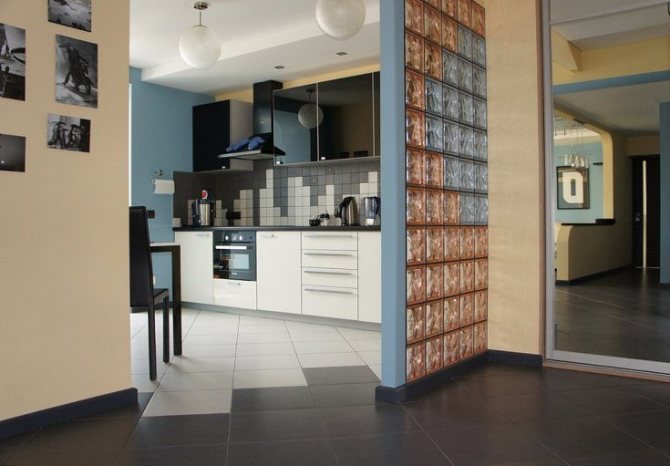

Where and when are glass blocks used?
- For decoration and construction of interior walls. This is especially true for apartment redevelopment or in the design of a public lobby, office corridor. Glass blocks help to zone and lighten the space, and in general the glass wall looks original. For comfort, glass blocks are best combined with different materials of warm colors (drywall or brickwork). Glass blocks that are pointwise recessed into the wall will not let light through too much, but they will reflect it beautifully, creating a play of shadows. A separate design solution is a glass bay window, a rounded or just curly wall with inserts. If such a wall forms a free niche, you can make an area for souvenirs or various decor items in it.
- When creating partitions. It is in this version that glass blocks are popular in the bathroom, and any photo on the Web will confirm this. With different widths, heights and ornaments, it is especially convenient to make a glass partition in a combined bathroom. The material goes well with tiles, does not deteriorate from moisture, is easy to clean and does not grow moldy. Frosted glass blocks will create a more intimate area, i.e. separate beautiful shower cubicle of the required shapes and sizes. However, the bathroom is not the only place in the interior of which a glass partition looks appropriate. So, with its help, you can divide the kitchen into a dining room and a work area, as well as the entire studio apartment into areas for rest, work and receiving guests. Partitions can be arched, round and oval, trapezoidal and even pyramidal. They can also be “stuffed” from the inside with LEDs, adding soft light for relaxation, for example, in the bedroom.
- In the decoration of the windows. Frosted and transparent windows can be used as inserts in pools and bathrooms. For decoration, such a window with a mosaic pattern or film stained-glass window can be made in the living room by decorating the opening with light curtains. Finally, a decorative window of any shape can connect the kitchen and the bathroom or the dining room and the corridor. Glass blocks allow you to increase the light transmission capacity of the window, but the air in such structures circulates poorly, so it quickly becomes stuffy. But a decorative window in the bathroom can additionally become a base for a mirror or shelves.
- When laying floors. Glass blocks are very durable, and if you take large matte models with a rough surface, you can get a high-quality flooring. The best design option would be to put a backlight under it. Glass floors are undesirable only in bathrooms, kitchens and hallways: dirt from the street or splashed water can make the surface very slippery.
- When laying the roof. Glass blocks are often built into the gable sections of roofs to illuminate the attic or attic. In private homes, this solution helps to create a greenhouse and winter garden with natural light. And if you make a glass roof with a glass floor, you can achieve the effect of a completely airy and light space.
- For creating furniture and decor items. Practical glass can become the basis of a kitchen "island", a panel, a luminous bar counter, a console under the sink, a cabinet dining table and even a coffee table. However, it is worth considering that such furniture is desired on rigid frames, so it will not work to move it. Glass blocks can be used to decorate kitchen aprons, doorways and mirrors.Also from these elements are laid out actions for podiums or stairs and decorative fireplaces.
Glass block walls
Today, many owners of small-sized apartments prefer to eliminate walls and partitions that are not load-bearing, to form interior structures of a more modern and convenient format.
Walls made of glass blocks allow you to perfectly zone the space and effectively beat the modern design of any apartment.
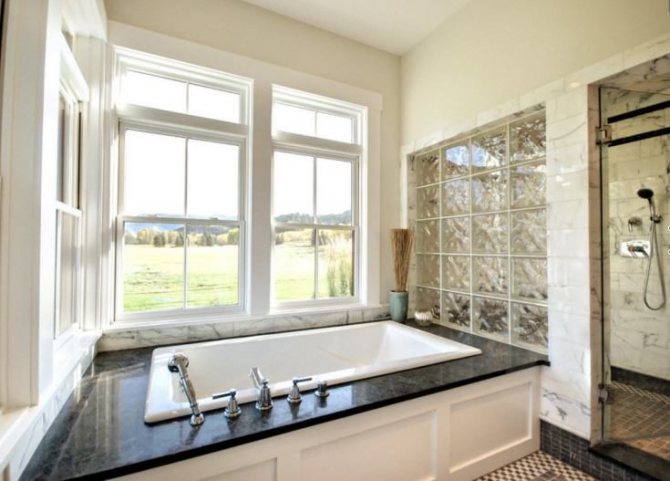

Interior walls made of transparent blocks are an ideal solution for the improvement of dark halls, corridors, lobbies, where a lot of sunlight will enter through a glass prism, but the effect of seclusion and detachment of one room from another will remain.
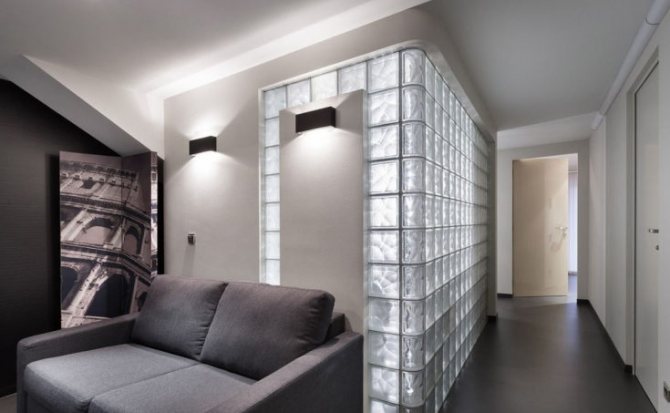

The use of glass blocks in large quantities is associated with some aesthetic difficulties.
The design may seem too cold, soulless. "Ice cubes" in the interior of the apartment must be supplemented with other materials with a warmer, more comfortable texture.
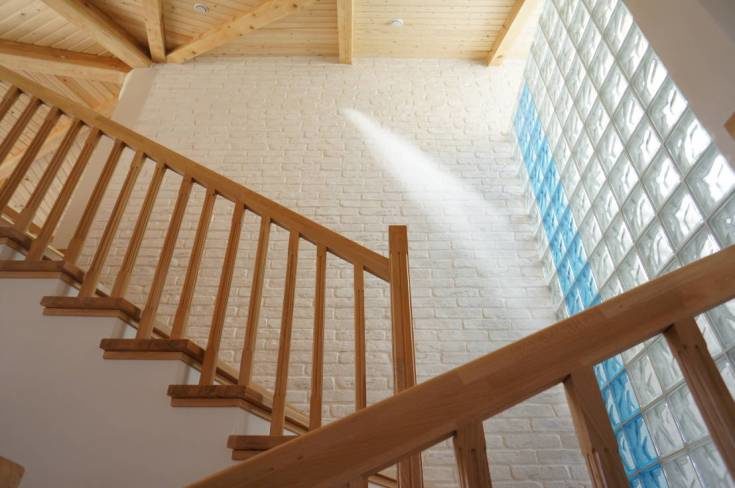

Disadvantages of glass blocks
Unfortunately, there are no perfect materials yet. Despite the advantages and merits of glass bricks, they are also not without a flaw. In fairness, we note the main negative points that can be encountered when using glass blocks in the interior.
The heavy weight of the block makes the structure much heavier, therefore it is not recommended to create walls with an area of more than 15 square meters. meters. Installation is quite laborious and requires certain knowledge and skills.
The next important point is the high cost of the material. The price from Russian manufacturers varies from 120 to 220 rubles per piece, European quality will cost much more, on average 300-500 rubles. The price for decorative blocks with figures and volumetric paintings in the inner cavity is around 1,500 rubles. In Moscow, you can buy any, including non-standard, options from different manufacturers at the best prices, while for the provinces it will be problematic to find a suitable option.
It is impossible to hang any decor or shelves on finished walls and partitions made of glass blocks. Although the problem with shelves can be solved by creating special niches.
Glass block partitions
In modern interior design of apartments and houses, it is customary to form partitions of a non-standard forms:
- Pyramid;
- Trapezium;
- Ziggurat;
- Steps;
- Arch;
- Oval;
- Round designs with holes.
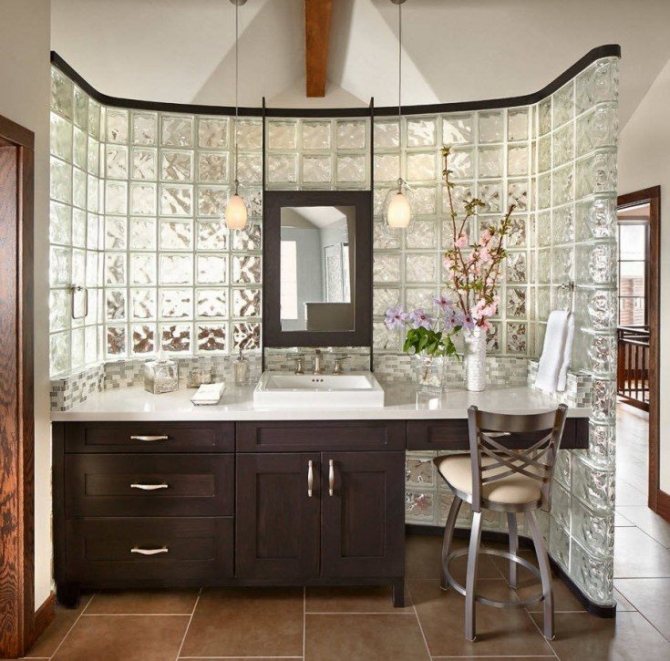

A shower cabin made of glass blocks or a partition in a bathroom made of such decorative elements perfectly repeats the rhythm of the tiles on the walls, emphasizing the cold aesthetics. The glass is not afraid of moisture, temperature changes, diffuses light well.
It is possible to "insulate" the sterility of glass partitions with the help of decorative installations inside the blocks.
Shells and other watery themes can be used in modern bathroom designs. For the kitchen, more relevant gastronomic ornaments and compositions. For example, fill the voids of transparent glass blocks with coffee beans or dummies of fruit.
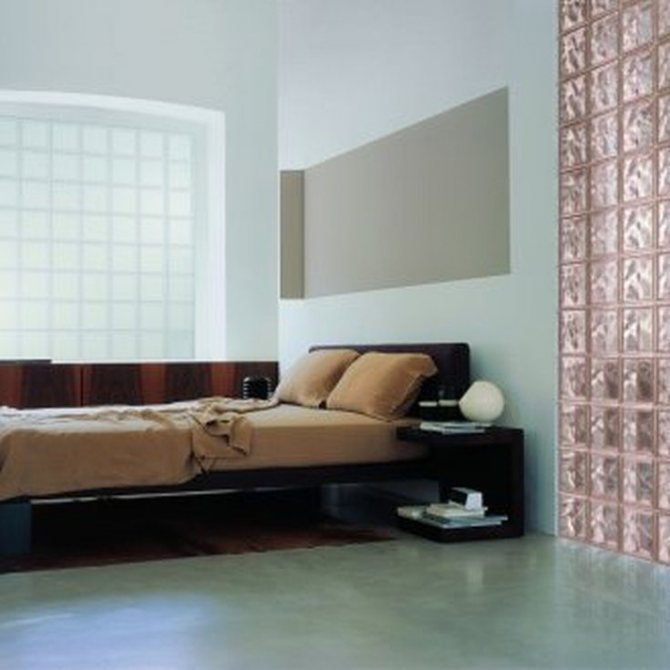

Benefits
Among the advantages of glass in home improvement are:
- Visual appeal. The blocks are partially (almost completely) transparent - this effect changes the perception of the room, creates a feeling of lightness and airiness. This is the main reason for arranging mobile and stationary partitions with glass. Separately, it should be noted the great possibilities of etching and tinting glass, the use of colored edging.
- Ease of maintenance. This implies the minimum need for simple dry cleaning with a soft cloth. But it is important to understand that glass elements will not be able to withstand heavy loads and are afraid of chips and scratches.
- Resistant to temperatures. A serious advantage of the reviewed products.The sun's rays and the proximity of heating devices do not pose any threat to glass block structures. However, it is not recommended to place them near open sources of fire (fireplaces).
- Durability. It implies an impressive service life, resistant to degradation and aging. Glass does not fade, does not turn yellow, does not accumulate black mold.
- Resistant to liquids. In a flood, the glass wall will not get wet, in some cases it can even help stop unwanted moisture.
- Stylistic versatility. In all styles of modern and postmodern, glass in the form of bricks 25 by 25 centimeters will look more than appropriate. In grunge and loft, glass just asks to sit in a niche, to take on the role of a window.
Formation of window openings
Often, interior windows in apartments and houses are formed precisely with the help of spectacular glass blocks. They give lightness, airiness to the walls, and allow better quality dispersion of the sun's rays.
Particularly noteworthy are illuminated designs that look great in the design of living rooms, bedrooms and hallways.
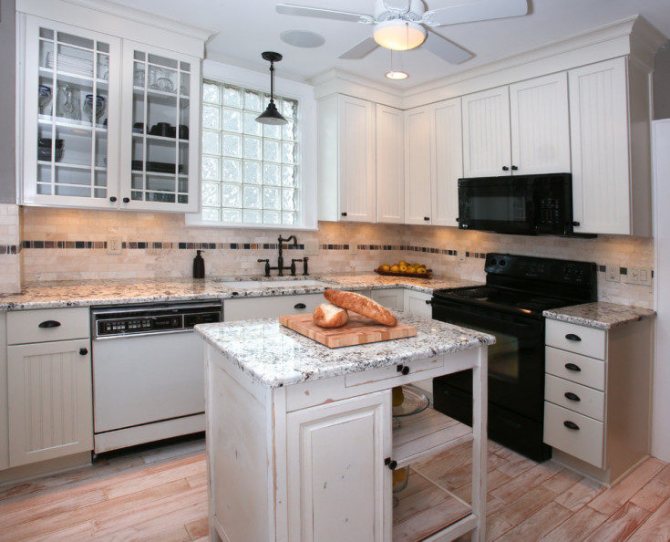

Installation of partitions from glass blocks
The creation of structures from glass blocks is a simple process. Installation of partitions from glass blocks includes the following steps:
- Determination of the installation site of the partition.
- Preparation and cleaning of the mounting surface. With the help of rails, you need to outline the boundaries of the base of the structure.
- Laying the first row of glass blocks.
- Installation of stainless steel reinforcing bar. It is not recommended to stack more than 3 rows of blocks per day, as the structure may bend.
- After the mixture has completely dried, you need to remove the crosses and the protective film on the blocks, start applying the trowel mixture.
- After cleaning the partition and its complete drying, it is necessary to protect the structure from moisture by applying a waterproofing liquid.


Laying glass blocks
- There are two main types of installation of glass blocks: the use of plastic or wooden modules and laying the material on a cement mortar. Using the first option, you can fold the wall, like a constructor, inserting glass blocks into all or only the required cells.
- When using the second mounting method, it must be borne in mind that the seam will be replenished with a special agent (dye), which means that the cells must be completely empty. Such masonry is very similar to brick.
- It must also be remembered that glass blocks do not absorb moisture, and the wall dries out for a long time. Therefore, the structure must be laid gradually, 2–4 times a day, and the commissioning itself into the wall operation should be carried out no earlier than after 7–8 days.
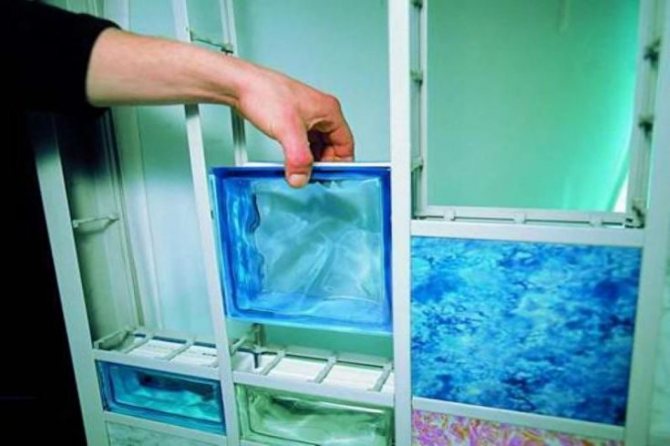

Features of installation of glass blocks
For those who have experience in laying tiles or brick walls, the issue of installing glass blocks will not seem difficult. However, you need to know some subtleties.
Installation of glass blocks can be carried out in two ways: in a joint on a special adhesive solution and on a special frame base (module) in the form of a lattice with cells. The second option is simpler in execution, but it is not always possible to find a suitable base.
The first way. To begin with, a profile is attached to the floor, along which the first block is laid. The rows should be laid away from the wall. Special crosses are installed between the blocks. Considering the large weight of the blocks and the long time of reliable binding of the solution to the block surface, the laying is carried out in stages, making the time interval between every third row.
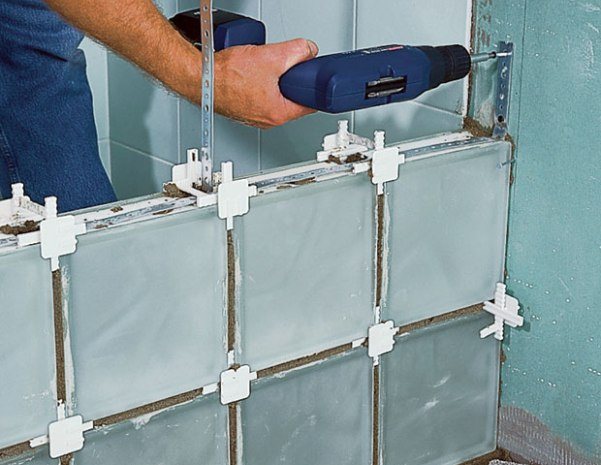

For the strength of the structure, metal rods are laid, avoiding contact of the rod with the block using mounting crosses. When the laying is completed, grout is carried out. Upon completion of all installation work, you can remove the protective film from the blocks.
Second way. A wooden frame or a module with cells of the appropriate size can be purchased at a hardware store. Before starting work, the frame must be securely fixed to the floor, ceiling and adjacent wall.
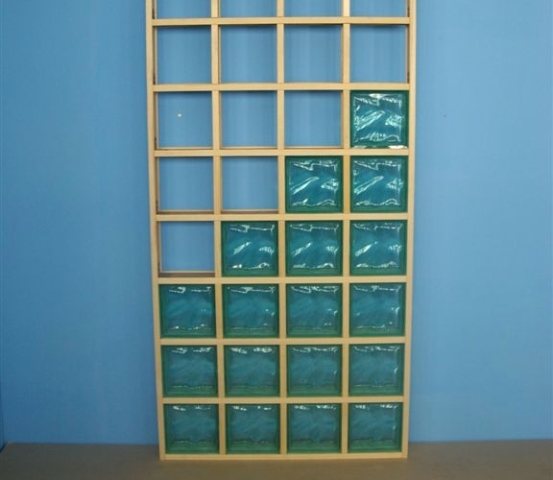

With such a module, the glass blocks are laid using rubber gaskets, and the blocks can be removed and replaced if necessary. This method is used to create decorative partitions.
Glass blocks in design: how to combine correctly
First of all, it is worth immediately separating the concepts of "glass wall" and "classic style". The classics do not tolerate such tricks and, as a result, glass blocks cannot be used in interiors decorated in the spirit of Baroque, Renaissance, Empire style - in any classics. Not always combined with country and provence.
If you do not have professional knowledge, it is better not to take risks so as not to get bad taste.
This is where such designs fit perfectly - these are high-tech, modern, modern and, under certain circumstances, minimalism. Perfectly transparent cubes will complement the loft space, highlight and emphasize its brutality.
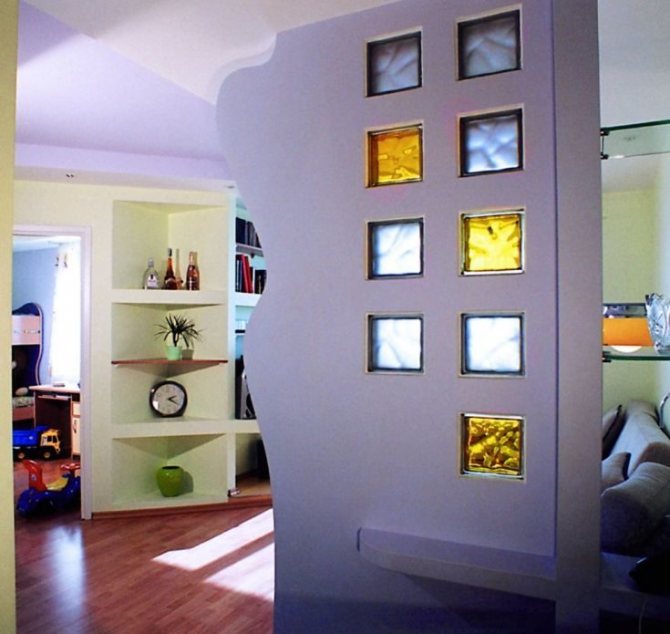

Stylish design ideas
Listed below are popular design solutions using whole, pivot and semi-block glass structures. In the photo you will see the implementation of false panels, decorative niches, space zoning, creating windows in the full height of the wall and other similar things.
General tips for using glass blocks in the interior of an apartment
- To prevent the living room from turning into an office, add colors to the interior.
- When decorating the space with blocks, add metal, wooden details or textiles - for example, a carpet will look very cozy.
- It is ideal to use glass blocks in the bathroom interior. You can even make a whole shower partition out of them. See for yourself: such a finishing material perfectly waterproofs, does not darken the space, “removes” the noise of water. And if you add colored parts, lighting and marine decor inside the block, it will come out just great.
- Pros believe that the total number of glass tiles for all other materials should be approximately 1 in 10. Stick to this rule - redundancy has never been in anyone's hands.
- In no case should they replace the load-bearing walls in the house and do not include individual squares in such structures. Glass in the interior is exclusively about decor and beauty.
- Need to delimit several active zones in one room? A translucent wall is ideal for this.
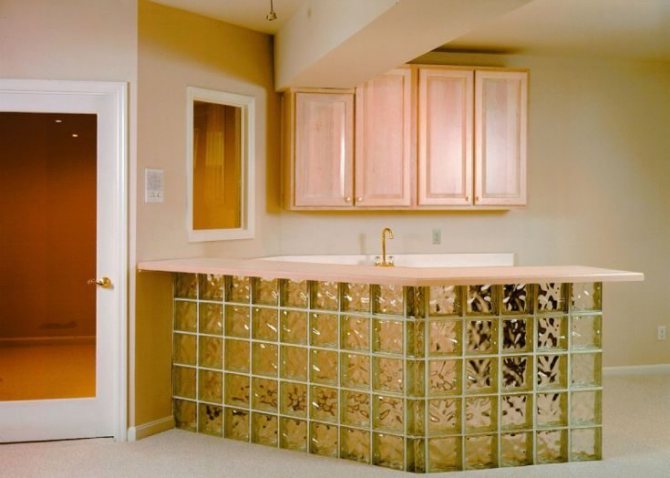

Advantages of glass blocks for interior furnishing
Almost every designer in his life at least once, but worked with glass bricks and laid out their photos in the interior. Where does this seemingly simple material come from so popular? It turns out that glass blocks have a lot of advantages, not counting their acceptable cost.
- Noise isolation. The air gap in such a glass "sandwich" allows noise retention by 60-70%. Therefore, blocks are often used in bathrooms and kitchens so that the sound of water does not reach the neighboring rooms.
- High light transmission. Transparent block models transmit 70-90% of light rays, colored ones - 50-70%, and matte ones - up to 50%. This is a high indicator of light transmission, so glass blocks help save on artificial lighting in the house. In addition, light can be either directional or diffuse.
- Privacy of space. The blocks are made of dense glass, which blurs the lines. With such material, you are reliably protected from prying eyes without any curtains and blinds.
- Strength and thermal conductivity. According to the first indicator, glass blocks can be safely compared with bricks: in order to break such material, one must resort to a sledgehammer. According to the second criterion, due to the interlayer with air, the blocks bypass the brick, because keep warm much better.
- Resistant to aggressive environments. Glass blocks are not afraid of moisture, fungus, scratches and rust, and can also easily withstand powerful temperature drops.
- Versatility. Glass blocks are suitable for literally everything. They are in demand in construction, finishing work, furniture production and decor.The imagination of technologists and designers is limitless, so glass is suitable for zoning an apartment, lighting a house and visually expanding the space. You can work with blocks not only in the interior, but also in the exterior. This means that correctly selected blocks will give any room a stylish and harmonious look.
- Rich assortment. Today's glass bricks have dozens of shapes and textures. Glass blocks in the interior can be monochromatic and multi-colored, matte and shiny, smooth and wavy, diamond and grainy. Moreover, each model gives its own unique light effect in space. So for a room in any style, you can make unique walls from glass blocks or pick up an elegant piece of furniture.
- Easy care. You can wipe the glass blocks many times with any detergent (for example, liquid for windows), or you can do it with a regular damp cloth. Repairing a glass block structure is also easy: just replace the damaged element.
- Environmental friendliness and incombustibility. The blocks are made of natural recyclable material, they, if necessary, protect from dust and dirt from the street, do not emit harmful substances into the air and do not support combustion. By the way, blocks can be safely heated without melting and cracking for a whole hour.
- No need for additional finishing. When the wall, floor or partition is ready, they no longer need to be painted or plastered.
